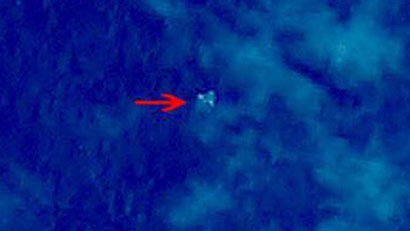
The multinational search effort for the aircraft, which was to become the most expensive aviation search in history, began in the Gulf of Thailand and the South China Sea, where the aircraft's signal was last detected on secondary surveillance radar, and was soon extended to the Strait of Malacca and Andaman Sea. It disappeared from ATC radar screens at 01:22 MYT, but was still tracked on military radar as it turned sharply away from its original northeastern course to head west and cross the Malay Peninsula, continuing that course until leaving the range of the military radar at 02:22 while over the Andaman Sea, 200 nautical miles (370 km 230 mi) northwest of Penang Island in northwestern Malaysia. The aircraft, a Boeing 777-200ER operated by Malaysia Airlines, last made voice contact with ATC at 01:19 MYT, 8 March (17:19 UTC, 7 March) when it was over the South China Sea, less than an hour after takeoff.

Map showing the scheduled destination of the flight and the wider surrounding region These include increased battery life on underwater locator beacons, lengthening of recording times on flight data recorders and cockpit voice recorders, and new standards for aircraft position reporting over the open ocean. In the absence of a definitive cause of disappearance, air transport industry safety recommendations and regulations citing Flight 370 have been intended mostly to prevent a repetition of the circumstances associated with the loss. The Malaysian Ministry of Transport's final report from July 2018 was inconclusive, but highlighted Malaysian ATC's failures to attempt to communicate with the aircraft shortly after its disappearance.

At various stages of the investigation, possible hijacking scenarios were considered, including crew involvement, and suspicion of the airplane's cargo manifest many disappearance theories regarding the flight have also been reported by the media. Relying mostly on analysis of data from the Inmarsat satellite with which the aircraft last communicated, the Australian Transport Safety Bureau (ATSB) proposed initially that a hypoxia event was the most likely cause given the available evidence, although no consensus has been reached concerning this theory among investigators. A second search launched in January 2018 by private contractor Ocean Infinity also ended without success after six months. After a three-year search across 120,000 km 2 (46,000 sq mi) of ocean failed to locate the aircraft, the Joint Agency Coordination Centre heading the operation suspended its activities in January 2017. Several pieces of debris washed ashore in the western Indian Ocean during 20 many of these were confirmed to have originated from Flight 370. The lack of official information in the days immediately after the disappearance prompted fierce criticism from the Chinese public, particularly from relatives of the passengers, as most people on board Flight 370 were of Chinese origin. It focused initially on the South China Sea and Andaman Sea, before a novel analysis of the aircraft's automated communications with an Inmarsat satellite indicated that the plane had traveled far southward over the southern Indian Ocean. The search for the missing airplane became the most expensive search in the history of aviation. The combined loss caused significant financial problems for Malaysia Airlines, which was renationalised by the Malaysian government in August 2014.

With all 227 passengers and 12 crew aboard presumed dead, the disappearance of Flight 370 was the deadliest incident involving a Boeing 777 and the deadliest in Malaysia Airlines' history until it was surpassed in both regards by Malaysia Airlines Flight 17, which was shot down while flying over eastern Ukraine four months later on 17 July 2014. It left radar range 200 nautical miles (370 km 230 mi) northwest of Penang Island in northwestern Peninsular Malaysia. The aircraft was lost from ATC's secondary surveillance radar screens minutes later, but was tracked by the Malaysian military's primary radar system for another hour, deviating westward from its planned flight path, crossing the Malay Peninsula and Andaman Sea. The crew of the Boeing 777-200ER, registered as 9M-MRO, last communicated with air traffic control (ATC) around 38 minutes after takeoff when the flight was over the South China Sea. Malaysia Airlines Flight 370 ( MH370/ MAS370) was an international passenger flight operated by Malaysia Airlines that disappeared on 8 March 2014 while flying from Kuala Lumpur International Airport in Malaysia to its planned destination, Beijing Capital International Airport in China. North Borneo dispute ( Philippine militant attacks)


 0 kommentar(er)
0 kommentar(er)
